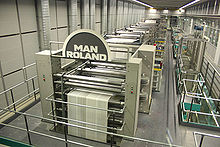Offset printing is a commonly used printing technique in which the inked image is transferred (or "offset") from a plate to a rubber blanket, then to the printing surface. When used in combination with the lithographic process, which is based on the repulsion of oil and water, the offset technique employs a flat (planographic) image carrier on which the image to be printed obtains ink from ink rollers, while the non-printing area attracts a water-based film (called "fountain solution"), keeping the non-printing areas ink-free.
Development of the offset press came in two versions: in 1875 by Robert Barclay of England for printing on tin, and in 1903 by Ira Washington Rubel of the United States for printing on paper.
Lithography was initially created to be a low cost method of reproducing artwork. This printing process was limited to use on flat, porous surfaces because the printing plates were produced from limestone. In fact, the word 'Lithograph' historically means "an image from stone." Tin cans were popular packaging materials in the 19th century, but transfer technologies were required before the lithographic process could be used to print on the tin.
The first rotary offset lithographic printing press was created in England and patented in 1875 by Robert Barclay. This development combined mid-19th century transfer printing technologies and Richard March Hoe’s 1843 rotary printing press—a press that used a metal cylinder instead of a flat stone. The offset cylinder was covered with specially treated cardboard that transferred the printed image from the stone to the surface of the metal. Later, the cardboard covering of the offset cylinder was changed to rubber, which is still the most commonly used material.

As the 19th century closed and photography captured favor, many lithographic firms went out of business. Photoengraving, a process that used halftone technology instead of illustration, became the leading aesthetic of the era. Many printers, including Ira Washington Rubel of New Jersey, were using the low-cost lithograph process to produce copies of photographs and books. Rubel discovered in 1901—by forgetting to load a sheet—that when printing from the rubber roller, instead of the metal, the printed page was clearer and sharper.After further refinement, the Potter Press printing Company in New York produced a press in 1903.By 1907 the Rubel offset press was in use in San Francisco.
The Harris Automatic Press Company also created a similar press around the same time. Charles and Albert Harris modeled their press “on a rotary letter press machine,”
Present day
Compared to other printing methods, offset printing is best suited for cost-effectively producing large volumes of high quality prints in an economically sound manner that requires little maintenance.
Applications
Offset lithography is one of the most common ways of creating printed matter. A few of its common applications include: newspapers, magazines, brochures, stationery, and books.
Many modern offset presses use computer to plate systems as opposed to the older computer to film workflows, which further increases their quality.
Advantages
Advantages of offset printing compared to other printing methods include:
· Consistent high image quality. Offset printing produces sharp and clean images and type more easily than letterpress printing because the
rubber blanket conforms to the texture of the printing surface.
· Quick and easy production of printing plates.
· Longer printing plate life than on direct litho presses because there is no direct contact between the plate and the printing surface.Properly
developed plates running in conjunction with optimized inks and fountain solution may exceed run lengths of a million impressions.
· Cost.
Offset printing is the cheapest method to produce high quality printing in commercial printing quantities.
· A further advantage of offset printing is the possibility to adjust the amount of ink on the fountain roller with screw keys. Most commonly
a metal blade controls the amount of ink transferred from the ink trough to the fountain roller. By adjusting the screws the gap between the
blade and the fountain roller is altered, leading to the amount of ink applied to the roller to be increased or decreased in certain areas.
Consequently the density of the colour in the respective area of the image is modified. On older machines the screws are adjusted manually,
but on modern machines the screw keys are operated electronically by the printer controlling the machine, enabling a much more precise
result.
Ink is transferred from the ink duct to the paper in several steps :-